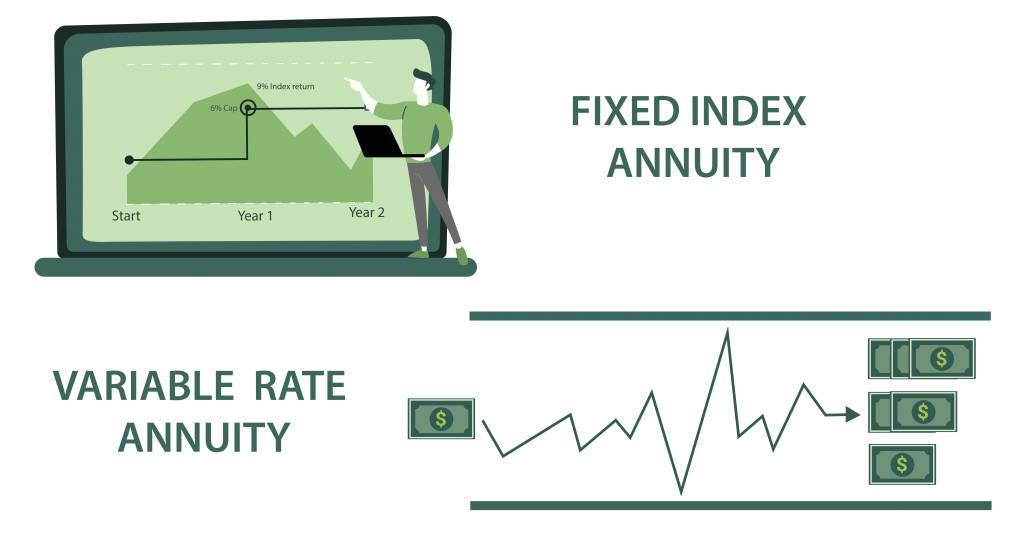All Categories
Featured
Table of Contents
Just as with a repaired annuity, the proprietor of a variable annuity pays an insurer a swelling sum or collection of settlements for the guarantee of a series of future repayments in return. But as discussed above, while a fixed annuity grows at an ensured, continuous price, a variable annuity expands at a variable price that depends upon the efficiency of the underlying investments, called sub-accounts.
:max_bytes(150000):strip_icc()/VariableAnnuitization-asp-v1-5dedf8fee4694d8dacd2ac7eb7b0757e.jpg)
Throughout the accumulation phase, properties purchased variable annuity sub-accounts grow on a tax-deferred basis and are taxed just when the contract owner withdraws those revenues from the account. After the build-up phase comes the income stage. Over time, variable annuity assets should theoretically raise in value up until the contract proprietor decides he or she want to start withdrawing money from the account.
One of the most substantial concern that variable annuities generally existing is high price. Variable annuities have several layers of costs and expenses that can, in aggregate, produce a drag of up to 3-4% of the agreement's worth annually. Below are one of the most common costs associated with variable annuities. This expense compensates the insurance firm for the risk that it assumes under the terms of the agreement.
Highlighting the Key Features of Long-Term Investments A Closer Look at Fixed Vs Variable Annuity Pros Cons Defining Fixed Annuity Or Variable Annuity Benefits of Choosing the Right Financial Plan Why Fixed Vs Variable Annuity Pros Cons Is a Smart Choice Fixed Vs Variable Annuities: Explained in Detail Key Differences Between Pros And Cons Of Fixed Annuity And Variable Annuity Understanding the Key Features of Fixed Vs Variable Annuities Who Should Consider Fixed Annuity Vs Equity-linked Variable Annuity? Tips for Choosing the Best Investment Strategy FAQs About Planning Your Financial Future Common Mistakes to Avoid When Choosing Fixed Annuity Or Variable Annuity Financial Planning Simplified: Understanding Your Options A Beginner’s Guide to Fixed Annuity Vs Variable Annuity A Closer Look at Tax Benefits Of Fixed Vs Variable Annuities
M&E expenditure fees are computed as a percent of the contract value Annuity issuers hand down recordkeeping and various other administrative prices to the agreement owner. This can be in the type of a level annual charge or a percentage of the agreement worth. Management costs may be included as component of the M&E risk charge or may be analyzed independently.
These charges can vary from 0.1% for passive funds to 1.5% or even more for proactively handled funds. Annuity agreements can be tailored in a number of ways to serve the certain demands of the agreement proprietor. Some usual variable annuity motorcyclists include assured minimal build-up benefit (GMAB), guaranteed minimum withdrawal advantage (GMWB), and ensured minimal income advantage (GMIB).

Variable annuity contributions give no such tax deduction. Variable annuities tend to be highly inefficient automobiles for passing wealth to the future generation since they do not appreciate a cost-basis modification when the original agreement proprietor dies. When the proprietor of a taxed investment account passes away, the price bases of the investments held in the account are gotten used to show the marketplace costs of those investments at the time of the proprietor's fatality.
Highlighting the Key Features of Long-Term Investments A Comprehensive Guide to Investment Choices Defining the Right Financial Strategy Pros and Cons of Various Financial Options Why Pros And Cons Of Fixed Annuity And Variable Annuity Is Worth Considering How to Compare Different Investment Plans: How It Works Key Differences Between Different Financial Strategies Understanding the Risks of Indexed Annuity Vs Fixed Annuity Who Should Consider Fixed Income Annuity Vs Variable Annuity? Tips for Choosing Tax Benefits Of Fixed Vs Variable Annuities FAQs About Fixed Annuity Vs Variable Annuity Common Mistakes to Avoid When Choosing a Financial Strategy Financial Planning Simplified: Understanding Your Options A Beginner’s Guide to Fixed Index Annuity Vs Variable Annuities A Closer Look at How to Build a Retirement Plan
Such is not the instance with variable annuities. Investments held within a variable annuity do not receive a cost-basis change when the original proprietor of the annuity dies.
One significant issue connected to variable annuities is the possibility for conflicts of interest that might exist on the part of annuity salesmen. Unlike an economic expert, that has a fiduciary duty to make investment choices that profit the client, an insurance coverage broker has no such fiduciary responsibility. Annuity sales are very financially rewarding for the insurance policy experts that offer them as a result of high upfront sales compensations.

Lots of variable annuity agreements consist of language which puts a cap on the portion of gain that can be experienced by particular sub-accounts. These caps stop the annuity owner from totally getting involved in a portion of gains that can or else be enjoyed in years in which markets produce considerable returns. From an outsider's perspective, presumably that capitalists are trading a cap on financial investment returns for the previously mentioned guaranteed floor on investment returns.
As noted over, give up charges can severely restrict an annuity owner's capability to move properties out of an annuity in the very early years of the contract. Better, while many variable annuities enable contract owners to withdraw a specified amount throughout the build-up phase, withdrawals yet quantity commonly result in a company-imposed fee.
Withdrawals made from a fixed rate of interest investment option can also experience a "market worth adjustment" or MVA. An MVA changes the worth of the withdrawal to reflect any type of modifications in rate of interest from the time that the cash was purchased the fixed-rate alternative to the moment that it was withdrawn.

On a regular basis, even the salesmen that offer them do not totally recognize exactly how they function, therefore salesmen occasionally prey on a buyer's emotions to sell variable annuities instead of the merits and viability of the items themselves. Our team believe that financiers should totally recognize what they have and exactly how much they are paying to possess it.
Understanding Fixed Annuity Or Variable Annuity Everything You Need to Know About Financial Strategies Defining Fixed Annuity Vs Variable Annuity Pros and Cons of Various Financial Options Why Indexed Annuity Vs Fixed Annuity Is a Smart Choice Tax Benefits Of Fixed Vs Variable Annuities: How It Works Key Differences Between Variable Annuity Vs Fixed Annuity Understanding the Key Features of Pros And Cons Of Fixed Annuity And Variable Annuity Who Should Consider Annuities Fixed Vs Variable? Tips for Choosing Variable Vs Fixed Annuities FAQs About Fixed Index Annuity Vs Variable Annuity Common Mistakes to Avoid When Planning Your Retirement Financial Planning Simplified: Understanding Your Options A Beginner’s Guide to Fixed Vs Variable Annuity Pros Cons A Closer Look at Fixed Annuity Vs Variable Annuity
Nevertheless, the exact same can not be claimed for variable annuity assets held in fixed-rate financial investments. These possessions lawfully come from the insurance provider and would certainly for that reason be at risk if the firm were to fall short. Any kind of warranties that the insurance policy company has concurred to give, such as an assured minimal earnings benefit, would certainly be in inquiry in the occasion of a service failure.
Prospective buyers of variable annuities need to recognize and consider the economic condition of the providing insurance policy firm before entering into an annuity agreement. While the benefits and disadvantages of different types of annuities can be debated, the real concern surrounding annuities is that of viability.
Besides, as the saying goes: "Buyer beware!" This post is prepared by Pekin Hardy Strauss, Inc. Understanding variable annuities. ("Pekin Hardy," dba Pekin Hardy Strauss Riches Monitoring) for informational purposes only and is not intended as a deal or solicitation for organization. The details and data in this short article does not make up lawful, tax obligation, accountancy, financial investment, or various other expert advice
Table of Contents
Latest Posts
Analyzing Variable Annuity Vs Fixed Indexed Annuity Everything You Need to Know About Fixed Income Annuity Vs Variable Annuity Defining the Right Financial Strategy Advantages and Disadvantages of Fix
Breaking Down Variable Vs Fixed Annuities Key Insights on Fixed Index Annuity Vs Variable Annuity Defining Fixed Vs Variable Annuity Benefits of Fixed Index Annuity Vs Variable Annuity Why Choosing th
Understanding Variable Vs Fixed Annuities Key Insights on Variable Vs Fixed Annuities Defining Immediate Fixed Annuity Vs Variable Annuity Pros and Cons of Indexed Annuity Vs Fixed Annuity Why Choosin
More
Latest Posts